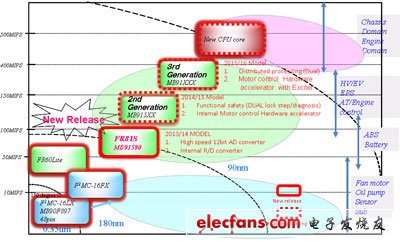China's auto industry continues to sit firmly on the "throne" of the world's first car production and sales, but it is followed by a series of social problems: the internationally recognized safety warning line of crude oil dependence of more than 50%; car exhaust accounts for more than the city's exhaust gas 65%..... New energy vehicles provide the best opportunity for global solutions to environmental and energy problems brought about by traditional energy vehicles, and become a hot spot of global concern. At the China (Chongqing) Automotive Electronics Summit Forum held recently, electronic design based on new energy vehicles has also become a hot topic.
“In fact, in addition to the different driving methods, there is no essential difference between new energy vehicles and traditional vehicles. Better driving and riding experience and higher safety are still the main challenges of automotive design.†Fujitsu Semiconductor (Shanghai) Co., Ltd. Wang Wei, Marketing Director, pointed out that “video technology is gaining more and more applications in terms of comfort and safety, and electric motors are the core components of new energy vehicles. High-efficiency, high-performance control technology is to achieve comfort and safety. An important guarantee. In this forum, Fujitsu demonstrated to China's automotive electronics manufacturers and OEMs the leading automotive electronic system solutions to solve the new energy vehicle design challenges.
Motor control is the key to new energy vehicles
In recent years, the concept of frequency conversion has become an absolute hot spot for home appliances including air conditioners, washing machines, refrigerators, etc. The key to this is the control technology of the motor. As the core component of new energy vehicles, electric motor motor control requirements are higher - the smooth operation of the motor, fast start and brake, and motor efficiency are all related to the key technology of motor control, which will directly affect the efficiency of power utilization. Car performance, driving experience and safe driving.
As the world's leading supplier of traditional consumer and industrial motor control solutions, Fujitsu is also at the forefront of new energy vehicle motor control, and its 32-bit motor control MCU MB91F267NA has achieved many successful applications. Recently, Fujitsu has released three new electric vehicle motor control MCU MB91580 series for the unique demand for motor control of new energy vehicles. A member of the FR family of high-performance 32-bit flash embedded microcontrollers (MCUs), the family is widely used for motor control in electric and hybrid vehicles. The series of energy-saving automotive drive motor control chips have a dedicated embedded resolver sensor interface that can pioneerably control three-phase motors used in electric and hybrid vehicles.

A hybrid inverter is an inverter that combines the functions of an inverter and a charge controller. Its main function is to simultaneously process the direct current generated by solar panels and the electric energy of the battery energy storage system in a photovoltaic power generation system. It converts the direct current generated by the solar panels into alternating current for power and stores the excess power in the battery so that it can continue to supply power when needed.
Main effect:
Solar power generation: Hybrid inverters convert the direct current generated by solar panels into alternating current for home, commercial, or industrial electricity needs.
Battery energy storage: The hybrid inverter is equipped with a battery energy storage system that can store excess solar power. When the Solar Panel cannot generate enough electricity, the electricity stored in the battery can continue to supply electricity to achieve a continuous power supply.
Grid-connected function: Some hybrid inverters also have grid-connected functions, that is, the excess electric energy is integrated into the grid for use by other users. This allows them to interact with the grid, be self-sufficient, and export electricity to the grid.
Differences from other inverters:
Charging control function: The hybrid inverter combines the functions of an inverter and a charge controller, and can simultaneously process the DC power of the solar panel and the DC power of the battery energy storage system, realizing the hybrid application of solar power generation and battery energy storage.
Standalone operation: Unlike microinverters, hybrid inverters can operate independently and do not require an inverter for each solar panel, so it may be more economical and convenient when the system is larger.
Applicable scenarios: Hybrid inverters are widely used in home, commercial, and industrial photovoltaic power generation systems, especially in hybrid application scenarios that require photovoltaic power generation and battery energy storage.
In general, the main function of the hybrid inverter is to convert the direct current of the solar panel and the battery energy storage system into alternating current, so as to realize the hybrid application of photovoltaic power generation and battery energy storage. Compared with other inverters, it has higher flexibility and reliability in energy management and power supply stability.
solar hybrid inverter system, eco worthy solar hybrid inverter, solar panel hybrid inverter, 24 volt hybrid solar inverter, hybrid solar inverter with battery backup
Ningbo Autrends International Trade Co., Ltd. , https://www.aitsolarpanels.com